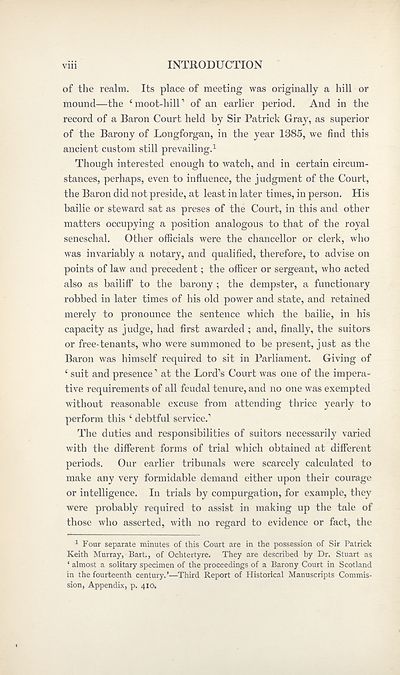Series 1 > Court book of the Barony of Urie in Kincardineshire, 1604-1747
(19) Page viii
Download files
Complete book:
Individual page:
Thumbnail gallery: Grid view | List view

INTRODUCTION
viii
of the realm. Its place of meeting was originally a hill or
mound—the ‘ moot-hill1 of an earlier period. And in the
record of a Baron Court held by Sir Patrick Gray, as superior
of the Barony of Longforgan, in the year 1385, we find this
ancient custom still prevailing.1
Though interested enough to watch, and in certain circum¬
stances, perhaps, even to influence, the judgment of the Court,
the Baron did not preside, at least in later times, in person. His
bailie or steward sat as preses of the Court, in this and other
matters occupying a position analogous to that of the royal
seneschal. Other officials were the chancellor or clerk, who
was invariably a notary, and qualified, therefore, to advise on
points of law and precedent; the officer or sergeant, who acted
also as bailiff to the barony; the dempster, a functionary
robbed in later times of his old power and state, and retained
merely to pronounce the sentence which the bailie, in his
capacity as judge, had first awarded ; and, finally, the suitors
or free-tenants, who were summoned to be present, just as the
Baron was himself required to sit in Parliament. Giving of
4 suit and presence1 at the Lord’s Court was one of the impera¬
tive requirements of all feudal tenure, and no one was exempted
without reasonable excuse from attending thrice yearly to
perform this ‘ debtful service.’
The duties and responsibilities of suitors necessarily varied
with the different forms of trial which obtained at different
periods. Our earlier tribunals were scarcely calculated to
make any very formidable demand either upon their courage
or intelligence. In trials by compurgation, for example, they
were probably required to assist in making up the tale of
those who asserted, with no regard to evidence or fact, the
1 Four separate minutes of this Court are in the possession of Sir Patrick
Keith Murray, Bart., of Ochtertyre. They are described by Dr. Stuart as
‘ almost a solitary specimen of the proceedings of a Barony Court in Scotland
in the fourteenth century.’—Third Report of Historical Manuscripts Commis¬
sion, Appendix, p. 410.
viii
of the realm. Its place of meeting was originally a hill or
mound—the ‘ moot-hill1 of an earlier period. And in the
record of a Baron Court held by Sir Patrick Gray, as superior
of the Barony of Longforgan, in the year 1385, we find this
ancient custom still prevailing.1
Though interested enough to watch, and in certain circum¬
stances, perhaps, even to influence, the judgment of the Court,
the Baron did not preside, at least in later times, in person. His
bailie or steward sat as preses of the Court, in this and other
matters occupying a position analogous to that of the royal
seneschal. Other officials were the chancellor or clerk, who
was invariably a notary, and qualified, therefore, to advise on
points of law and precedent; the officer or sergeant, who acted
also as bailiff to the barony; the dempster, a functionary
robbed in later times of his old power and state, and retained
merely to pronounce the sentence which the bailie, in his
capacity as judge, had first awarded ; and, finally, the suitors
or free-tenants, who were summoned to be present, just as the
Baron was himself required to sit in Parliament. Giving of
4 suit and presence1 at the Lord’s Court was one of the impera¬
tive requirements of all feudal tenure, and no one was exempted
without reasonable excuse from attending thrice yearly to
perform this ‘ debtful service.’
The duties and responsibilities of suitors necessarily varied
with the different forms of trial which obtained at different
periods. Our earlier tribunals were scarcely calculated to
make any very formidable demand either upon their courage
or intelligence. In trials by compurgation, for example, they
were probably required to assist in making up the tale of
those who asserted, with no regard to evidence or fact, the
1 Four separate minutes of this Court are in the possession of Sir Patrick
Keith Murray, Bart., of Ochtertyre. They are described by Dr. Stuart as
‘ almost a solitary specimen of the proceedings of a Barony Court in Scotland
in the fourteenth century.’—Third Report of Historical Manuscripts Commis¬
sion, Appendix, p. 410.
Set display mode to:
![]() Universal Viewer |
Universal Viewer | ![]() Mirador |
Large image | Transcription
Mirador |
Large image | Transcription
Images and transcriptions on this page, including medium image downloads, may be used under the Creative Commons Attribution 4.0 International Licence unless otherwise stated. ![]()
| Scottish History Society volumes > Series 1 > Court book of the Barony of Urie in Kincardineshire, 1604-1747 > (19) Page viii |
|---|
| Permanent URL | https://digital.nls.uk/127723953 |
|---|
| Attribution and copyright: |
|
|---|
| Description | Over 180 volumes, published by the Scottish History Society, containing original sources on Scotland's history and people. With a wide range of subjects, the books collectively cover all periods from the 12th to 20th centuries, and reflect changing trends in Scottish history. Sources are accompanied by scholarly interpretation, references and bibliographies. Volumes are usually published annually, and more digitised volumes will be added as they become available. |
|---|


